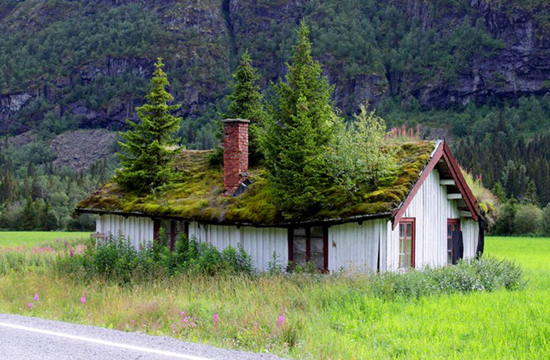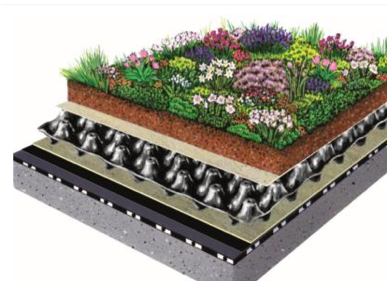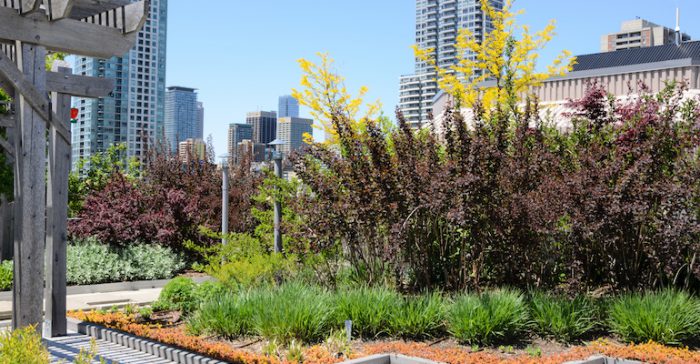Written by Brendan Hannon, ERS, for Zondits
In this two-part series, Zondits will explore green roofs as an emerging technology that can be a component of utility efficiency programs. Part 1 will focus on exploring the numerous benefits of green roofs. Part 2 will focus on changes in the efficiency universe that may make the technology more accessible for cities in the future.
Part 1: What Is a Green Roof?
A green roof refers to a type of rooftop construction that incorporates a layer of living plants into its design. Green roofs provide multiple benefits – in addition to their aesthetic value, they provide energy savings and reduce the amount of stormwater discharged into sewers. Surprisingly, green roofs can also be more durable than their bare counterparts. Plants absorb damaging UV rays that would otherwise break down a roof’s weatherproofing. Green roofs have already been widely adopted in other countries. Given renewed interest in the technology as a means to manage stormwater pollution, now is an excellent time to focus the energy efficiency industry on this new-old technology.
Green roofs have been around for thousands of years, but modern-engineered designs have seen new elements added to their sod forebearers. The technology consists of, at a minimum, a waterproof membrane, a root-repelling system, a drainage system, a growing medium, and plants. When installed correctly, the technology takes advantage of natural processes to reduce the energy needed to heat and cool the building.


Like other energy efficiency technologies, green roofs offer kilowatt and kilowatt hour savings. The greatest savings come from their ability to cool the roof during the peak of the day. Evapotranspiration, the process through which plants release water vapor through their leaves, harnesses energy that would otherwise be absorbed by the roof when temperatures and solar insolation peaks. Roof-mounted air handling units (AHUs) can realize further energy savings when installed on green roofs due to the lower ambient temperatures. Similarly, solar panels mounted above green roofs see increases in efficiency resulting from operating at lower temperatures.
A growing number of cities including New York, San Francisco, Denver, and Portland have passed laws mandating green roofs on new developments; water utilities in some of these cities also offer incentives to offset the costs of installing green roofs. As substantial as the energy savings can be, the surging interest in the technology is often driven by mandated reductions in stormwater going into sewer systems that impact water quality. On rainy days when bare roofs shed water to drains, green roofs store stormwater in specially designed drainage layers that irrigate the plants over the following days. By detaining and retaining water, these roofs can help municipalities avoid events when sewers discharge untreated sewage and rainwater directly into local waterways, called combined sewer overflows (CSOs).
Anyone discussing green roofs can end up sounding like Billy Mays – “But wait, there’s more!” Other benefits include:
- Sound insulation from outside noise for building occupants
- Increased property values
- Habitat creation for native plants, pollinators, and migratory birds
- Improvements in air quality
While numerous and significant, the monetary benefits of green roofs can be hard to quantify for individual property owners. Demand management programs have traditionally focused on easily quantifiable measures such as on-site generation or high-efficiency lighting. Unlike on-site generators that turn on during peak-cooling days, a green roof is not dispatchable nor is its load reduction easy to determine like efficient light bulbs, so energy utilities have been reluctant to incentivize the technology. While some municipalities offer tax rebates or reductions in sewer fees, for the most part, the high upfront cost of green roofs coupled with lingering concerns about the technology have stood in the way of rapid adoption.
Tune in for the next article in our series in which we discuss how recent changes in policy and long-term utility planning have made green roofs a more attractive technology. In addition, we’ll discuss what still needs to happen to see the widescale deployment of green roofs.
